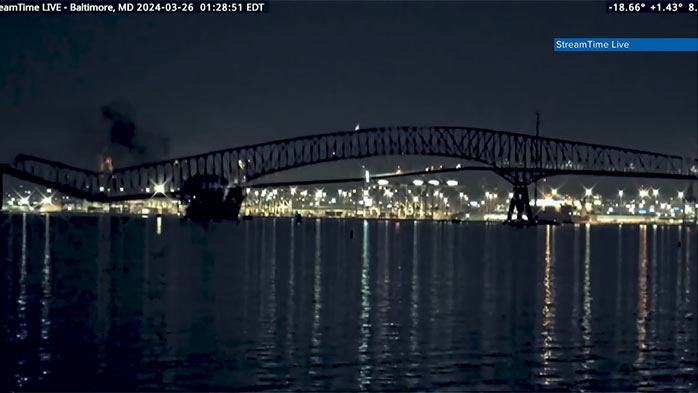Singapore cargo ship Dali was carrying toxic waste to Sri Lanka: Report

The Singapore cargo ship Dali, chartered by Maersk, crashed into the Baltimore, US bridge on Tuesday (March 26), while carrying 764 tons of hazardous materials bound for Sri Lanka, as reported by US media.
The hazardous cargo comprised mostly corrosives, flammables, miscellaneous hazardous materials, and Class-9 hazardous materials, including explosives and lithium-ion batteries, contained in 56 containers.
This information was provided by the US National Transportation Safety Board, which is still analyzing the ship’s manifest to determine the contents of its other 4,644 containers.
Prior to the incident in Baltimore, the Dali had made stops at New York and Norfolk, Virginia, the latter being home to the world’s largest naval base. Its next scheduled port of call was Colombo, Sri Lanka, with a 27-day journey around South Africa’s Cape of Good Hope, timed to arrive shortly after New Year’s.
The US National Transportation Safety Board reported that the ship had been carrying 764 tons of hazardous materials, including explosives, in 56 containers destined for Sri Lanka. The investigation is ongoing to determine the contents of the remaining 4,644 containers.
The US Department of Homeland Security has also declared the waters near the crash site as ‘unsafe for divers.’ It remains unclear to whom the toxic materials and fuel were intended in Sri Lanka.
The bridge, designated as a ‘hazmat route’ for US trucks carrying hazardous materials, was closed following the incident.
Sri Lanka has become an increasingly crucial transit point for shipping, particularly amid conflicts in West Asia and East Africa.
The involvement of Maersk, a key player in global logistics, including significant ties to the US military, adds complexity to the situation. However, attempts to discern responsibility or accountability are hindered by the opaque nature of global shipping ownership.
The tragic incident underscores broader issues within the maritime industry, including concerns about environmental standards, labor practices, and safety regulations.
As investigations continue, questions remain about liability, insurance coverage, and the broader implications for global shipping practices.”
Latest Headlines in Sri Lanka
- Three Sri Lanka Police officers arrested for taking bribe from Austrian tourist March 7, 2025
- Ganemulla Sanjeewa murder case to be heard via Skype due to security concerns March 7, 2025
- Sri Lanka Police transfers 8 senior officers in major reshuffle March 7, 2025
- Mervyn Silva remanded until March 17, 2025 March 6, 2025
- Sri Lanka Police seek public help to locate former IGP Deshabandu Tennakoon March 6, 2025



Who is responsible for importing toxic material to Sri Lanka ? Why would anyone want to import such material ? Surely, the acting President should determine who is responsible !!! in the interests of the Country. Over to you Mr acting President.